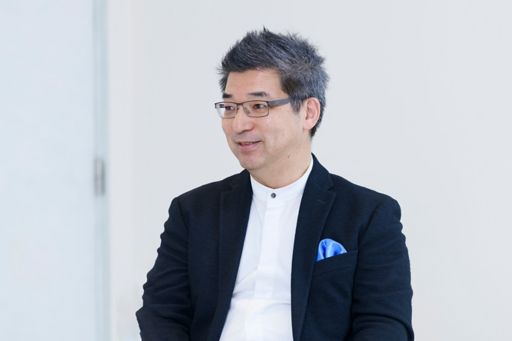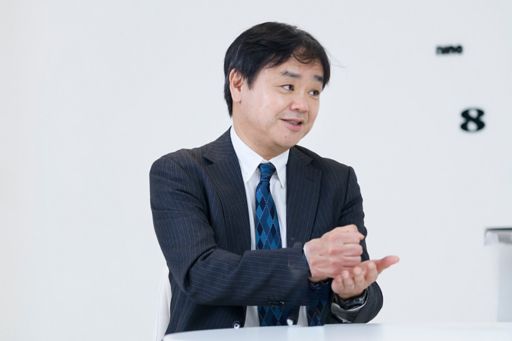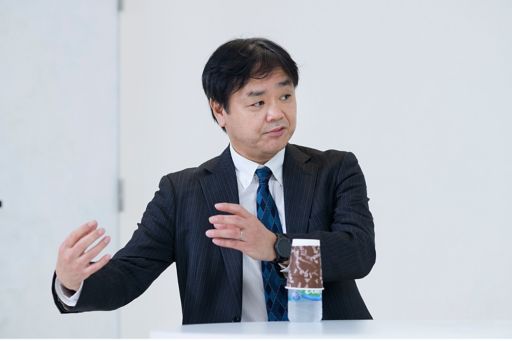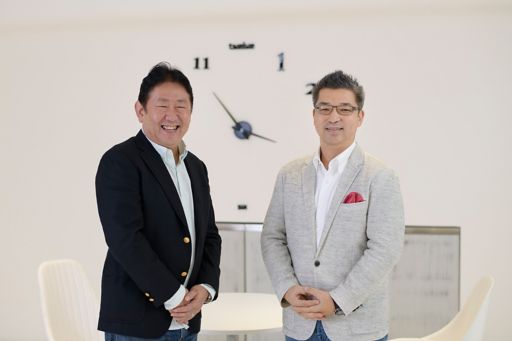In the world of business, the importance of SDGs and ESG has recently been advocated, with the word “sustainability” attracting significant attention. Meanwhile, as we all know, the word “digital transformation (DX)” is becoming a buzzword and the importance of DX at companies is increasing. As just described, we often hear the view that “sustainability” and “DX” will become the main strategic themes of companies in the post-COVID-19 world. However, there may not be so many people who realize that these two concepts are deeply interconnected.
Against this backdrop, Mitsubishi Chemical Holdings (hereafter referred to as Mitsubishi Chemical HD) is focusing on “ambidextrous DX”, which concurrently promotes DX for their current business issues and DX in anticipation of the future. It is also defining their management direction by focusing on “sustainability,” which includes seeking their ideal future 30 years from now while imagining society 50 years from now.
In this article, we will introduce a discussion between Masayuki Chatani from KPMG Ignition Tokyo and Naohiko Uramoto, Chief Digital Officer at Mitsubishi Chemical HD, who is playing a central role in promoting DX across the entire group. (Vol. 1)
Contents
- Promotion of DX Started in 2017 - Organizations Are Also Starting to Change Gradually
- What Is Indispensable in Promoting DX Is Internal Marketing
- How to Confront Technical Debt. Preparation and Responsibility for Declaring that “DX is Prior Investment”
- How Will Business Change With DX?
- Profile of Interviewee
Promotion of DX Started in 2017 - Organizations Are Also Starting to Change Gradually

(Naohiko Uramoto, Executive Officer and Chief Digital Officer, Mitsubishi Chemical Holdings Corporation (left) and Masayuki Chatani, Representative Director & CEO of KPMG Ignition Tokyo and CDO of KPMG Japan) *Professional affiliation and official position in the article are at the time of publication.
Chatani: What I would like to ask you about first is the announcement of the change of CEO at Mitsubishi Chemical HD as of April 1, 2021. The new CEO is reported to be Belgian-born Jean-Marc Gilson. As he is a foreign CEO, I am very interested in the responses to this move within the company including yours.
Uramoto: There may be some hesitation within the company, as he will be our first foreign CEO. On the other hand, our expectations are also high. As I used to work for a foreign-affiliated company before and my current boss is Larry Meixner, Chief Innovation Officer, I do not feel so uncomfortable. I am very interested in how he is going to drive the company and change the organization. I also feel that the role of our DX promotion team, which I belong to, will become more important in the new strategy.
Chatani: Inviting a CEO from abroad is a clear message that the company is accelerating toward global expansion. Are expectations within the company being expressed in that sense?
Uramoto: We gradually started to provide support to our overseas group companies a few years ago and there are several projects underway right now.
Mitsubishi Chemical HD’s major overseas bases are located in the U.S., Europe and Asia, and quite a few overseas bases are more advanced in terms of the digital shift. However, when it comes to DX, our headquarters has been promoting it since 2017 and has also accumulated assets, so we hope to share them with our overseas group companies and accelerate this movement.
Chatani: That sounds very promising. Speaking of Mitsubishi Chemical HD, its establishment through the merger of three companies—Mitsubishi Chemical, Mitsubishi Plastics and Mitsubishi Rayon—on April 1, 2017 was a big news. Even though the three companies belonged to the same holding group, there must have been differences in terms of corporate culture and, naturally, the products they were manufacturing. Especially in terms of DX, what concerned me was the difference in internal infrastructure and the digital platform. Have they been integrated already?
Uramoto: Various measures have been implemented since the company’s establishment in April 2017. As part of this wave, a major organizational restructuring is scheduled in April 2021 to pursue further synergies.
As for myself, I will probably have more opportunities to work with different organizations in each group entity. When the DX Team was set up at Mitsubishi Chemical HD, there were hardly any related organizations around us. Now, there are DX promotion organizations and personnel in each company and I am collaborating with them very closely. I also feel that the relationship between digital and IT, including the promotion of DX, is gradually changing. When we started promoting DX three years ago, there were times when the goals, sense of speed and requirements differed between the digital team and the team promoting internal IT and it was sometimes better to work separately.
However, there have recently been many occasions when we have worked together even though we are still organizationally separate. I think this means that digital and IT are gradually being integrated.
For instance, as we normally start with small projects in the digital field, we often proceed by implementing PoC (Proof of Concept) and create a prototype. When this process actually goes well and advances to the stage when it is incorporated in the company business, it will be necessary to establish a development and support system with a focus on operation. As we have to ask for the engagement of the IT Team at this stage, it will be necessary to realize a smooth transfer.
Meanwhile, as the question “how do we utilize the data we have?” is becoming a big theme, it will be necessary to introduce approaches to think about ways to use the data and try to put it into practice together with our IT Team and Digital Team. Such integration is indeed starting and occasions where both teams promote projects with shared goals are also increasing gradually.
What Is Indispensable in Promoting DX Is Internal Marketing
Chatani: By the way, wasn’t there any internal opposition when you started promoting DX three years ago? I believe that it is likely to become an issue in many companies.
Uramoto: When the team was established, 80% of the members had joined it from outside the company. So, I imagine that the responses were like, “people who came from outside the company are doing something complicated called DX.”
Over three years have passed since then, and now several divisions promoting DX have been set up within the group including at Mitsubishi Chemical. There is also a DX Division at Mitsubishi Tanabe Pharma Corporation. I think DX has permeated as a result of building a network of colleagues in this way.

On the other hand, it is a reality that there are still many people who do not think it concerns them, and they say things such as “what on earth is DX?” or “why should we promote it?” or “how does it help us in our life and work?” For instance, when visiting our domestic production bases and listening to their opinions, it seems that those who are involved in actual plant operation and sales, in particular, tend to be unfamiliar with DX still.
However, I have especially come to think recently that in order to expand our project, it is extremely important to have these staff at the work front consider DX as something that concerns them. They are precisely the people we are trying to reach right now.
Chatani: You used to work for IBM before and I believe that you were on the side that recommended DX, if anything. On the contrary, you are now in a position that receives and implements it. Do you feel any difference in these positions?
Uramoto: Of course, we are colleagues with the plant operators and sales staff who are working in the same company. However, in terms of what we are actually doing, we are in a position to promote DX and so I feel that there are similarities with my previous work.
What I realized during these activities is that internal marketing is extremely important. We are taking various measures so that everyone will think of DX as something that concerns them, such as internal marketing, giving discussion opportunities and creating materials for training. External marketing is extremely important as well for sure. We are cooperating with the communications and HR teams to promote these activities.
How to Confront Technical Debt. Preparation and Responsibility for Declaring that “DX is Prior Investment”

Chatani: When we promote DX, there is always a so-called technical debt. Also, we often hear that one of the reasons why a solution with old technology cannot be migrated to a new one is the view that we should continue using it as long as it is indispensable to certain users.
I understand that you are encouraging a change to new technology assets while skillfully handling these technical debts. Is there anything you are paying attention to in this process?
Uramoto: I think there are two views in regard to so-called software world.
The first view is related to our core business. The life-cycle of products in the chemical industry is very long compared to those in the IT industry and it is not uncommon to use the same product for many decades. Therefore, the system for supporting this must continue for many years. This goes for ERP as well but it is assumed that the core system will be used for many years and the system will not change that dramatically.
The second view, on the contrary, is to increase productivity by using the best software and functions of the time during a span of about three years to create new value. This view has also become quite necessary.
It is important to understand these differences and utilize them properly but I think the reality is that such a distinction has not quite been recognized. This is why there is opposition even though it is better to skillfully use the latest technology. How to overcome this becomes important. As one of the solutions, we have recently been working on a project to jointly change the environment including software with the IT team from a relatively early stage. We are promoting the project by looking ahead to the operation stage.
Chatani: In many cases, digital transformation, in a sense, has the same meaning as corporate transformation (CX). In such cases, we are forced to carry out prior investment for an unforeseeable outcome. It is also true that in many cases we cannot advance forward without this prior investment. When making prior investments at Mitsubishi Chemical HD, how are decisions made?
Uramoto: Of course, there are intentions of top management such as business strategies as well as requirements from the worksite on the contrary. Fortunately, as our top management including the CEO is aware that DX is extremely important and that “the promotion of DX is necessary,” we are able to realize prior investments.
This is why we have been continuing our activities for more than three years already. We are also aware that we must clarify the outcomes. However, it is quite difficult to set and achieve KPIs. We are working very hard to measure “how much cost can be reduced or profit can be increased if we can do this” but it is sometimes difficult to accumulate the necessary information to set KPIs.
Of course, it is important for the entire company to understand that “DX is really necessary, inevitable, and an investment,” but on the other hand, we can’t afford to be too complacent about it. Therefore, I think that we have a responsibility to objectively indicate how we define KPIs and priorities and how we are going to achieve results.
The promotion of DX may look as if “there are mountains of small projects.” I am aware that we must consider how we are going to select and position small projects based on a big strategy and how we are going to monitor them with a sense of responsibility.
How Will Business Change With DX?
Chatani: Various things are changing as a result of promoting DX. For instance, I think that there will be changes in the working style of employees, manufacturing of products, business models and the concepts of distribution and supply chains. What do you think will change the most by promoting DX at Mitsubishi Chemical HD?
Uramoto: Mitsubishi Chemical HD Group can be roughly divided into three areas—the R&D Division, which carries out research and development, the Production Technology Division, which manufactures products at plants, and the Operation Division—with the Corporate Division including Human Resources overseeing these divisions. These four divisions are our main partners for promoting DX.
While carrying out various initiatives, our big theme, for instance, in research and development is “materials informatics.” While “bio informatics,” which integrates bioscience and informatics, has drawn much attention in recent years, “materials informatics” is basically the same from the standpoint that it utilizes informatics in the search for new materials.

We are basically called a chemical company or a material company, so before talking about “materials informatics,” let me explain what we are doing. When a chemical company creates new materials and ingredients, we receive orders concerning physical properties and characters such as “a solid but light material” or “ingredients for drip-proof paint.” The chemists then think about the formulation and molecular design for creating materials that satisfy these requirements and carry out experiments for verification. This process is repeated many times. It can be said that the source of assets of a chemical company is its recipes and know-how related to figuring out these recipes as well as its plant operation know-how related to manufacturing products as precisely and inexpensively as possible.
“Materials informatics” aims to foresee candidate formulation examples, molecular structures and designs based on a huge amount of data regarding new ingredients and materials, by inputting information such as “required physical properties.” What I just talked about is called “inverse estimation.” This is an extremely difficult field but if this is realized, the tasks of creating recipes based on experience and confirming the physical properties through experiments can be implemented automatically and so the R&D cycle is expected to shorten dramatically.
As you can see, “materials informatics” and the development of its basic is an important theme in the field of R&D and initiatives such as the visualization and optimization of the supply chain are being implemented. Especially amid current social conditions, the key will be how we can grasp the current situation and make swift decisions.
Also, the greatest impact in the field of manufacturing is the challenge of “how to stabilize production.” As a matter of fact, a big loss will arise if we have to stop a big plant for even one day. Therefore, I believe that production planning will stabilize remarkably if we can detect abnormalities in advance.
Chatani: I assume that an unstable production process is likely to develop into big problems such as the termination of a process and the deterioration of product quality.
Uramoto: That’s right. If a machine breaks down and our production process stops, this will cause trouble to the company that carries out the next process. For instance, a petrochemical plant is connected to a company that carries out the following process with a pipeline that conveys products. So, if a problem occurs, it will also affect the processes that follow and produce greater losses. At the present stage, we are only looking at the processes carried out at our company and the situation of the plants we are managing. However, we envisage that overviewing not just such a supply chain but also the entire value chain from research and development to production and distribution will accelerate the entire flow of the company.
Chatani: Aren’t these processes sufficiently digitalized yet?
Uramoto: No. My impression is that “each process point has been digitalized but these points have not been connected yet.”
Chatani: You talked about “materials informatics.” Are you acquiring information about not just known materials but also what is occurring inside the test tubes as data already? And are you developing such tools on your own or are they being provided by a third vendor?
Uramoto: Our company is accumulating massive quantities of data from past experiments and operation, and I believe that they will be of great value. Also, we are internally creating tools for utilizing these data. Our digital team has established the Center of Excellence (CoE) to accumulate and laterally deploy focused technologies and the Materials Informatics CoE is leading this activity.
By the way, there are 3 CoEs in total including text mining and mathematical optimization. IT vendors and start-ups are also launching data and tools. For instance, a massive database is necessary to do inverse estimation. It is a technology that can extract information such as “the temperature of this compound was...” from a research paper on chemistry by utilizing AI and language analysis features and create a database. There are companies that are providing this. We are developing tools on our own and also incorporating the tools of other companies.
Profile of Interviewee

Naohiko Uramoto
Executive Officer and Chief Digital Officer
Mitsubishi Chemical Holdings Corporation
Naohiko Uramoto joined IBM Japan in 1990 and was engaged in the research and development of natural language processing, web technology, security and cloud computing, etc., at its Tokyo Research Laboratory. He served as CTO of Bluemix Garage Tokyo in 2016 and joined Mitsubishi Chemical Holdings in 2017. He is promoting digital transformation utilizing AI and IoT technology. In April 2020, he became Chief Digital Officer. In addition, he concurrently served as President of the Japanese Society for Artificial Intelligence from 2018 to June 2020 and now as a visiting professor at Kyushu University. He has been a fellow of the Information Processing Society of Japan since 2020.
Follow us on KPMG Ignition Tokyo LinkedIn for the latest news.
Connect with us
- Find office locations kpmg.findOfficeLocations
- kpmg.emailUs
- Social media @ KPMG kpmg.socialMedia




